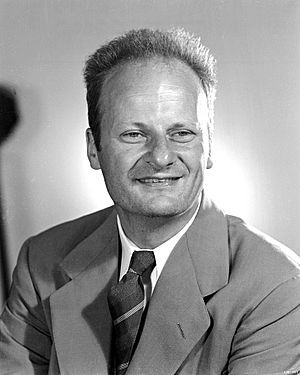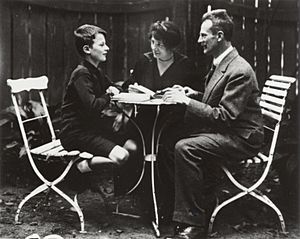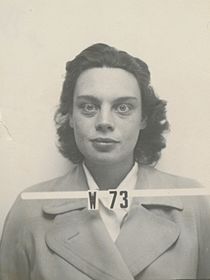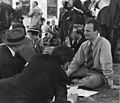Hans Bethe facts for kids
Quick facts for kids
Hans Bethe
|
|
|---|---|
 |
|
| Born |
Hans Albrecht Bethe
July 2, 1906 |
| Died | March 6, 2005 (aged 98) Ithaca, New York, U.S.
|
| Nationality | German American |
| Alma mater | University of Frankfurt University of Munich |
| Known for |
|
| Spouse(s) |
Rose Ewald (married in 1939; two children)
|
| Awards |
|
| Scientific career | |
| Fields | Nuclear physics |
| Institutions | |
| Thesis | Theorie der Beugung von Elektronen an Kristallen (1928) |
| Doctoral advisor | Arnold Sommerfeld |
| Doctoral students |
|
| Other notable students | Freeman Dyson |
| Signature | |
Hans Albrecht Bethe (born July 2, 1906 – died March 6, 2005) was a brilliant German-American physicist. He was a "theoretical physicist," which means he used math and ideas to understand how the universe works. He made huge discoveries in many areas of physics, like how stars create energy and elements (called stellar nucleosynthesis). For this important work, he won the Nobel Prize in Physics in 1967.
Contents
Early Life and Education
Hans Bethe was born in Strasbourg, Germany, on July 2, 1906. He was the only child of Anna and Albrecht Bethe, who was a university teacher of how living things work (physiology).
When Hans was 10, he got tuberculosis, a serious lung illness. He had to take a break from school to get better. After recovering, he went to different schools, including a private boarding school. He finished his high school studies in 1924.
In 1924, Bethe started studying at the University of Frankfurt. He first chose to study chemistry. However, he found the physics classes there were not very good. He also didn't like how the math teachers taught math without connecting it to science. So, in 1926, he moved to the University of Munich to continue his studies.
Career Highlights
Hans Bethe became a citizen of the United States in 1941. For most of his career, he was a professor at Cornell University, a famous school in New York.
World War II and the Atomic Bomb
During World War II, Bethe worked at a secret laboratory called Los Alamos National Laboratory. This was where scientists developed the first atomic bombs. Bethe was in charge of the "Theoretical Division." His team played a key role in figuring out how much nuclear material was needed for the bombs to work (called "critical mass"). They also helped develop the special "implosion method" used in the "Fat Man" bomb, which was dropped on Nagasaki in 1945.
The Hydrogen Bomb and Peace Efforts
After the war, Bethe also helped develop the hydrogen bomb. He actually joined this project hoping to prove that such a bomb could not be built.
Later in his life, Bethe became a strong supporter of peace. He worked with famous scientists like Albert Einstein to speak out against nuclear testing and the "nuclear arms race" (when countries build more and more nuclear weapons). He helped convince leaders like President Kennedy and President Nixon to sign important agreements. These agreements, like the 1963 Partial Nuclear Test Ban Treaty and the 1972 Anti-Ballistic Missile Treaty, aimed to limit nuclear weapons.
Nuclear Energy and Later Work
In the 1980s and 1990s, Bethe promoted the peaceful use of nuclear energy. After the Chernobyl disaster (a serious accident at a nuclear power plant), he helped study what went wrong. They found that the power plant had a bad design and that human mistakes also caused the accident.
In 1995, when he was 88 years old, Bethe wrote an open letter. In it, he asked all scientists to stop working on nuclear weapons. He believed it was important for scientists to use their skills for good.
Hans Bethe continued his scientific research even when he was in his nineties. He published important papers for almost 70 years! His former student, Freeman Dyson, called him the "supreme problem-solver of the 20th century."
Personal Life
Hans Bethe had many hobbies. He loved collecting stamps and enjoyed being outdoors. He was a very enthusiastic hiker and explored mountains like the Alps and the Rocky Mountains.
He married Rose Ewald on September 13, 1939. They had two children, Henry and Monica.
Hans Bethe passed away at his home in Ithaca, New York, on March 6, 2005, at the age of 98. He was a respected professor at Cornell University until his death.
Honors and Awards
Hans Bethe received many awards and honors throughout his life. Some of the most important include:
- The Henry Draper Medal in 1947
- The Franklin Medal in 1959
- The Enrico Fermi Award in 1961
- The Nobel Prize in Physics in 1967
- The National Medal of Science in 1975
- The Bruce Medal in 2001
- The Benjamin Franklin Medal in 2005 (given after he passed away)
He was also chosen as a Fellow of the American Academy of Arts and Sciences and a Foreign Member of the Royal Society in London.
Many places and awards have been named after him to honor his contributions:
- Hans Bethe House at Cornell University
- The Hans Bethe Center in Washington, D.C.
- The Bethe Center for Theoretical Physics at the University of Bonn in Germany
- An asteroid, 30828 Bethe, discovered in 1990
- The American Physical Society Hans Bethe Prize
Images for kids
-
Bethe's Los Alamos Laboratory ID badge
See also
 In Spanish: Hans Bethe para niños
In Spanish: Hans Bethe para niños






